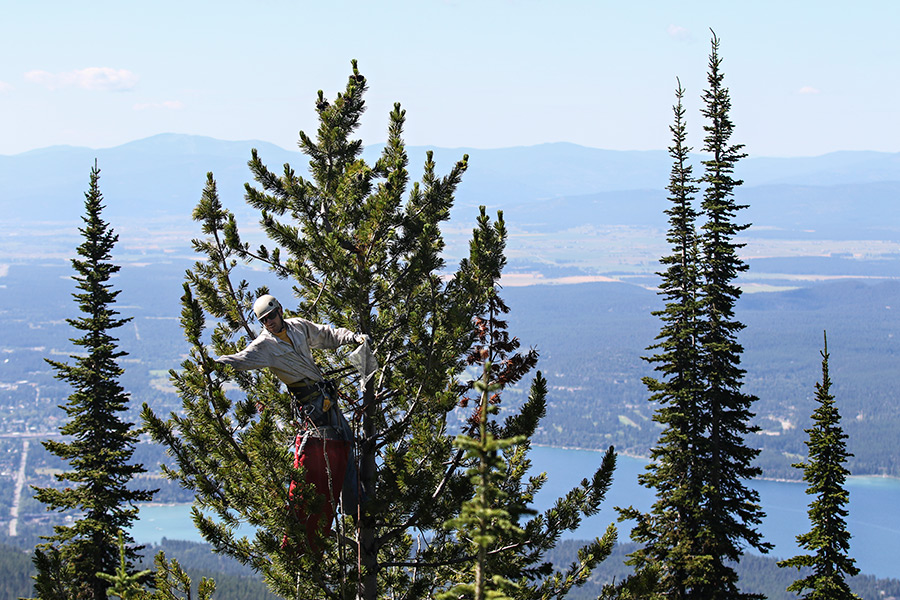National Park Service, American Forests Partner to Restore Whitebark Pines
The Interior Department is funding restoration projects of keystone species in Glacier, Yellowstone and Grand Teton national parks
By Micah Drew
A new five-year agreement between the National Park Service (NPS) and the nonprofit conservation organization American Forests aims to support restoration projects to expand the presence of the threatened whitebark pine in national parks.
The Department of the Interior last week announced the partnership as part of a $44 million investment from the Inflation Reduction Act to fund climate resilience projects across the National Park Service, including whitebark pine recovery efforts in Glacier, Yellowstone and Grant Teton national parks, areas where the iconic tree was once a mainstay on the forested landscape.
“This agreement is a pivotal step toward preserving the biodiversity and health of whitebark pine and its vital ecosystems,” said Brian Kittler, forest restoration lead with American Forests. “National parks are not just places to be enjoyed for their beauty and history, they also harbor vital habitat for the whitebark pine and other species in decline. Together, American Forests and the National Park Service are advancing the state of the science for conserving this life-giving tree.”
In any forested habitat, whitebark pines are considered a keystone species for the role the trees play in an ecosystem. The hardy pines grow at higher elevations, creating microenviroments for other trees and shrubs. Whitebark pine forests also help the region’s watersheds by regulating the flow of snowmelt downstream. The seeds of a whitebark pine are a key food source for the Clark’s nutcracker, black and grizzly bears, red squirrels and more than a dozen other species. For the Clark’s nutcracker in particular, the relationship with the whitebark pine tree is mutually beneficial, as the birds store seeds underground for spring feeding to chicks and forgotten caches will propagate the next generation of trees.

While historically whitebark pine trees made up roughly 20% of forested lands in Glacier National Park, and roughly 14% of the surrounding Flathead National Forest, nearly 90% of whitebark habitat has disappeared today. The exotic blister rust fungus, mountain pine beetles and climate change have taken a combined toll on the species with the Park Service estimating that more than 325 million pines have been lost across its historic range.
“Conserving whitebark pine forests across regions is key to the species’ persistence,” Dawn LaFleur, vegetation program manager for Glacier National Park, said in a press release. “Without these actions, threats from plant disease, beetle infestation, changing fire regimes and climate change could cause irreversible loss of whitebark pine and the ecosystem services provided by whitebark pine forests.”
The partnership between American Forests and NPS is part of the National Seed Strategy, an interagency public-private collaboration aimed at increasing the supply of native seeds available for restoration efforts.
“The National Seed Strategy spotlights how successful native plant restoration starts with having access to the rights seeds,” National Park Service Director Chuck Sams said in a press release. “Our agreement with American Forests will enable the collection of seeds from drought and disease resistant whitebark pines and ultimately help us to restore these trees in national parks.”

Over the last 15 years, several national parks, including Glacier and Yellowstone, have developed whitebark pine restoration programs with a more than 60% seedling survival rate, promoting the growth of trees resistant to blister rust. The seed collection and seedling propagation projects allows agency partners to map seed sources, maintain viable seed stock and collects enough to restore hundreds of acres of whitebark pine stands.
In Yellowstone, Glacier and Grand Teton national parks, American Forests is collaborating with land managers to pioneer direct seeding trials. The method, which involves planting seeds directly into the ground, as opposed to planting seedlings grown in greenhouses, may offer a low-impact and cost-effective alternative to restore whitebark pine in remote locations.
American Forests is also partnering with Yosemite, Kings Canyon and Sequoia national parks to identify and harvest cones from drought and disease-resistant whitebark pine trees. Seeds from resistant parent trees will be screened and cultivated to grow the next generation of climate-resilient forests in California.
The current whitebark pine projects fall in step with the National Whitebark Pine Restoration Plan, a science-driven interagency strategy that will be released later this year. To learn more about national efforts to protect and restore whitebark pine, visit SavetheWhitebarkPine.org.